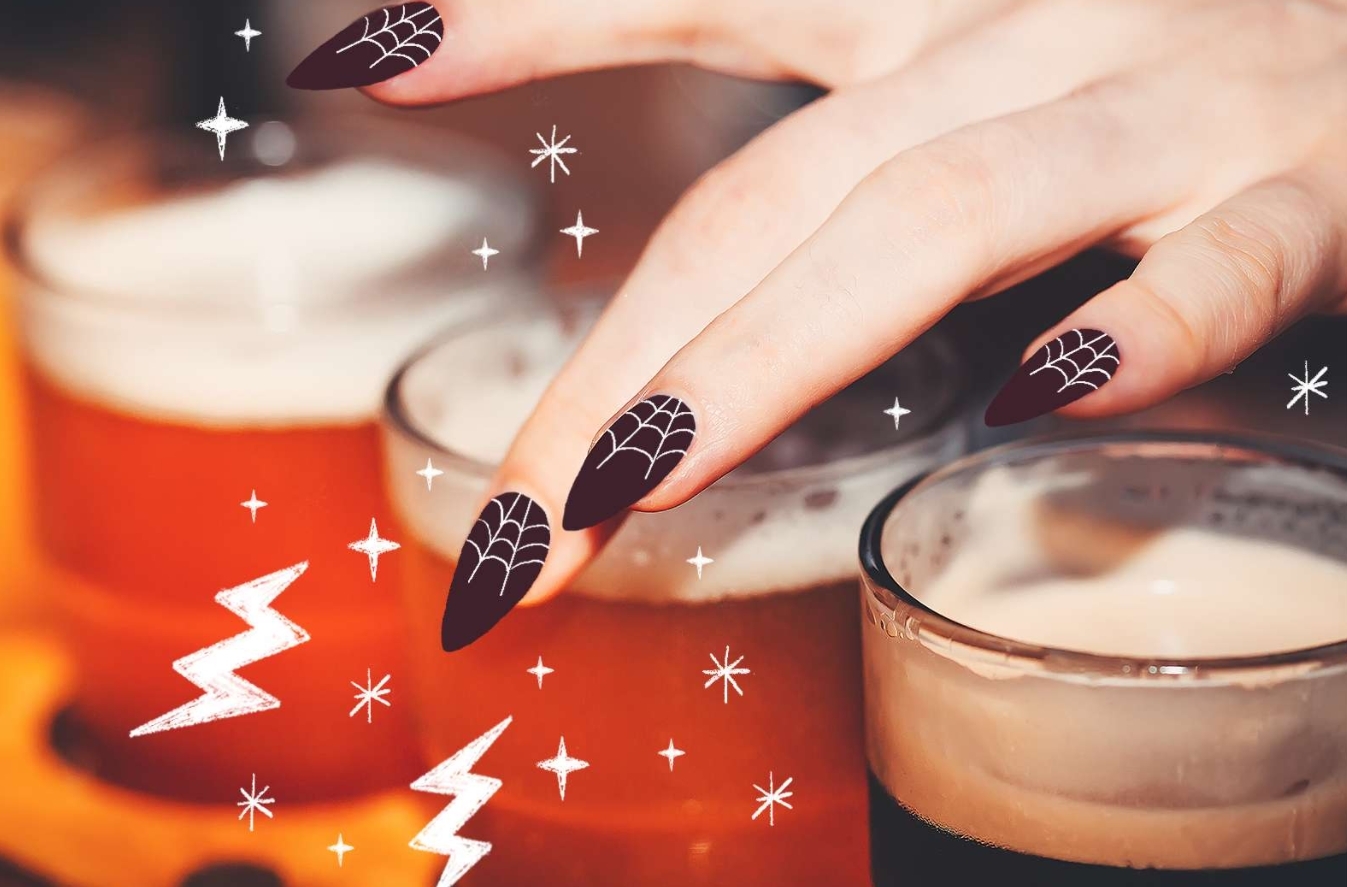Celerity
Celerity's JournalBiden should bring up Central Park Five if that orange berk wants to play race-bait games

Trump just started to say Biden tried to get rid of SOCIAL SECURITY, let that insane projection
sink in. Trump literally accuses others of having done, or wanting to do, or presently doing EXACTLY whatever evil, death-cult, anti-human bullshit HE himself does. 100% projection, 100% of the time.
IT IS MADNESS ON PARADE.
Meet the 'Witches' Who Pioneered Brewing Beer
https://www.thrillist.com/drink/nation/why-the-first-female-brewers-look-a-lot-like-witches
Beer is one of the most powerful elixirs around so it should come as no surprise that its origins are mysterious -- and involve a little “magic.” Some of the earliest brewers of the stuff have ties to witchcraft, and spooky symbols like tall pointed hats, cauldrons, broomsticks, and black cats actually have more in common with the brewing world than the underworld. It being Halloween, we partnered with Sierra Nevada’s Hazy Little Thing IPA to tell the whole story, both simplified (and silly) in the video below and the more complex version that follows.
(video at the top link)
Brewing beer as a household chore (and a lucrative one)
Historically, brewing ale was just another item on the long list of household duties women were responsible for; a tradition that goes all the way back to the Vikings. Fermented drinks like ale, mead, and wine, were typically safer to drink than water at the time, so stocking the stores with the stuff was essential. During Viking times, only women were allowed to keep and pass down these recipes, so female brewers took on something of a mystical allure. In fact, those who mastered brewing were usually known as shamans or priestesses, and they would sometimes tell fortunes -- especially when they had a little too much of their own supply. Fast forward to medieval Europe, where those female brewers became known as brewsters or alewives. These women found they could make a little extra cash if they took their extra product to local markets. Doing this was pretty popular, too, as noted in the book Ale, Beer, and Brewsters in England: Women's Work in a Changing World, 1300-1600. The author explains that in English villages like Brigstock and Yorkshire, nearly one-third of the female population brewed beer. “In short, almost every other household in the countryside brewed beer for profit,” she writes.
The alewife uniform looks eerily familiar…
With so many people offering relatively similar products at small-town markets, alewives and brewsters had to get creative to stand out. This is when certain “witchy” elements start to make their appearance. First, there’s the large, pointed hats worn to catch people’s eye and let them know you had a little extra homebrew. (One popular image of a historic alewife shows such a hat.) It wasn’t just hats, though: the large vats used for brewing were called cauldrons at the time. Broomsticks, AKA “ale stakes” were usually stuck in the ground outside homes that had extra beer for sale, too. Some would also hang six-pointed stars, which were said to represent the key components of brewing. And, of course, keeping a cat around to deter mice from getting into your grain stores was incredibly common. These symbols weren’t just in Europe, either: In Peru, female brewers would attach red, dried bouquets to broomstick handles to signal they had beer for sale.
Hops makes the situation murkier
So, if all these symbols actually came from female brewers, why are they associated with cackling witches today? To get to that answer, you first have to look at what these female brewers were, well, brewing. Technically, they were making ale with just three simple ingredients: water, malt, and yeast. That yielded a sweeter, more sessionable, and slightly unstable brew. By the early 1500s, brewers in one tiny English town added a key ingredient: hops. This addition makes the ale into beer, and it’s similar to what we know today: more bitter, higher alcohol content -- and thus, it stays fresher, longer. Hops was pricier than other ingredients, and harder to come by, so beer quickly became a more commercial product, and one dominated by men, rather than women.
snip
I do not see how, even with Biden as POTUS, the US will stop COVID-19
100 million (or so) MAGAts and their families, plus their non-voting brethren, plus the Red/Purple states (especially with Rethug Governors) power structures (and local Red areas as well) in full coronaviral rebellion equals:
1. They will not socially distance, and I suspect they will only increase their violent attacks on mask wearers and social distancers, or people to try to force the insurrectionists to comply
2. They will not close their businesses, even temporarily in numbers large enough to have universal systemic impact
3. They will not wear masks, they will not stop meeting in large groups
4. A huge number (some non Rethugs too) will not take a vaccine (which will be only partially effective IF one is even found)
5. Local law enforcement in many cases will not enforce shit (even in Blue states)
6. They will not close schools in many cases, they will not close their churches, nor their sporting events, in so many cases
7. The will travel to states and areas in their own states that ARE following safety regulations and practices, and spread it there
8. They will violently resist orders, and it will get FAR worse when it is a Democratic POTUS who is trying to crack down
9. A defeated Trump and other RW sources (Fux Newz, OANN, hate radio, hate internet, YT, Twitter, FB, etc etc) will stir up insurrection, resistance, non-compliance non-stop resistance and sabotage of Biden and all Democratic attempts at mitigation.
10. Even herd immunity may not work (even after 2 to 3 million plus die) due to mutations, or a going away of T-Cell and antibody immunity, or simply the percentages needed to for herd immunity to work never being reached.
I am sure I have left a lot out, too.
How does Biden change this? Nationwide martial law? That will cause insane violence and resistance, and there just isn't enough enforcement personnel in terms of raw numbers.
Colour me very pessimistic the US can come to grips with the pandemic, even with a massive Blue Wave in the elections. I can see it TRULY becoming a global pariah state, with Americans banned from entering many nations (barring a 2 or 3 week managed quarantine once they fly or drive in) years, and basically being known chiefly as a death projector.
I so, so, so welcome/am-open-to any suggestions/programmes/hopes/alternative scenarios, etc etc that show me as being dead wrong.
![]()
These Are the Top Food Trends to Look for in 2021, According to Whole Foods
Looking to spice things up in the kitchen?https://www.thrillist.com/news/nation/food-trends-2021-list-whole-foods

You might think of Whole Foods as that place where you buy slightly more expensive foods that can at least make you feel like you're eating healthier. You may not have realized, however, that the Amazon-owned grocer also moonlights as a sort of culinary Nostradamus. Every year, Whole Foods unveils a list of the food trends it believes will become notable in the coming year. Some items on the list might feel slightly more Carnac the Magnificient than Nostradamus, telling us about trends already in progress or, possibly, things that sound a bit far-fetched. The list of "10 anticipated food trends" is pulled together by Whole Foods' Trends Council, which is comprised of "more than 50 Whole Foods Market team members, including local foragers, regional and global buyers, and culinary experts." The forecast for 2021 is unavoidably impacted by the global pandemic.
Eating, dining, and shopping habits have changed dramatically under the specter of COVID-19. "There have been radical shifts in consumer habits in 2020," Sonya Gafsi Oblisk, CMO at Whole Foods, says. "For example, shoppers have found new passions for cooking, they’ve purchased more items related to health and wellness, and more are eating breakfast at home every day compared to pre-COVID. Food trends are a sign of the times, and our 2021 trends are no exception." However you might feel about the grocery store's effort to look deep into the crystal ball, it's well-positioned to see the trends coming and even make trends happen. Here is Whole Foods sees coming in 2021, a year which has to be more enjoyable than 2020. Fingers crossed.
"The lines are blurring between the supplement and grocery aisles," Whole Foods writes in its announcement, "and that trend will accelerate in 2021. That means superfoods, probiotics, broths, and sauerkrauts. Suppliers are incorporating functional ingredients like vitamin C, mushrooms and adaptogens to foster a calm headspace and support the immune system." Examples: Cleveland Kraut, Beekeeper's Naural B.Powered Superfood Honey, Om Mushroom Superfood Mighty Mushroom Broth, Navitas Organics Superfood+ Adaptogen Blend Smoothie Booster
Due to the pandemic, more people are cooking for themselves regularly. Part of that is what marketers have labeled as the most important meal of the day. Whole Foods says there are a ton of new products on shelves or coming soon that will be focused on breakfast with "people paying more attention to what they eat in the morning. Think pancakes on weekdays, sous vide egg bites, and even 'eggs' made from mung beans." Examples: Just Egg Folded plant-based "eggs," Meatless Farm: Meat-Free Sausage Patties, Meat-Free Breakfast Sausages, Birch Benders Pancake Keto Cups
snip
Want to Work Remotely Abroad? Try These 12 Cities for Digital Nomads
Try the digital nomad life on for size.https://www.thrillist.com/travel/nation/best-cities-in-the-world-working-remotely-cheap

If there’s one silver lining to 2020, it’s that now you know—and your boss knows, and their boss knows—you can work from just about anywhere. Maybe it’s from a swanky Airbnb for a week in a different city. Maybe it’s rollin’ in your rental RV with a WiFi hotspot. Or maybe it’s in the cerulean-hued paradise of the Caribbean, where islands are beckoning visitors with “workcation” packages and special tourist visas that let you hang out for months. Craving even more freedom? Join up with an international community of expats and remote workers who’ve been living the nomad life for years. Cities across the globe let you stay plugged in with fast internet and free WiFi flowing like wine (and just as often, fantastic wine flowing like wine). While many countries remain off-limits due to the pandemic, others are accepting Americans, like, right now. Reasonable living in these cities won't run more than $3,000 a month, they're all deemed generally safe for women, and they have high marks for racial tolerance and friendliness to foreigners. (If you’re interested, Nomadlist is a solid resource for digital nomads). Look to any of these cities for a month of working vacation—or, for that open-ended stint of earning and wandering.

Chiang Mai, Thailand

The Canary Islands, Spain

Wellington, New Zealand
snip
After Brutal Beheading, Rallies Erupt Across France To Honor Slain Teacher
https://www.npr.org/2020/10/18/925162409/after-brutal-beheading-rallies-erupt-across-france-to-honor-slain-teacher
Crowds gathered throughout France on Sunday to pay tribute to Samuel Paty, the 47-year-old history teacher who was beheaded after he reportedly showed cartoons of the Prophet Muhammad during a civics lesson. Rallies formed in cities including Paris, Lyon, Nantes, Toulouse, Strasbourg, Marseille and Bordeaux.
Thousands convened in Paris' Place de la République, which Huffington Post France reported was filled at times with the sounds of applause, the French national anthem and a solemn minute of silence. Attendees at demonstrations across the country carried signs reading "I am Samuel" and "I am a teacher," according to the BBC. France is reeling from the killing, which took place in the Paris suburb of Conflans-Sainte-Honorine on Friday.
According to police, an 18-year-old Chechen refugee attacked Paty near the school and cut his throat, before posting a graphic claim of responsibility on social media. Police fatally shot the attacker after he acted threateningly and did not respond to commands to disarm, authorities said. Shortly after, President Emmanuel Macron characterized it as "an Islamist terrorist attack" and said the teacher was targeted because he "taught freedom of expression."
Jean-François Ricard, France's anti-terrorism prosecutor, said Paty had received death threats after he allegedly showed caricatures of the Prophet Muhammad during a class about freedom of speech. The Muslim faith prohibits depictions of the Prophet Muhammad. The BBC reported that Paty advised Muslim students in the class to look away if they anticipated being offended.
snip
BREAKING The whole of Wales will begin a 17-day lockdown on Friday
A leaked document has revealed that Wales could be entering a ‘circuit breaker’ lockdown this week that will see the region go back into the restrictions first imposed in March. Over the weekend, Welsh First Minister Mark Drakeford said the nation’s devolved government was looking ‘very carefully’ at introducing a circuit-breaker lockdown in Wales to curb the rising infection rate in the region. The ‘circuit breaker’ lockdown would see pubs, restaurants and hairdressers closed and household mixing discouraged. If enforced, it is thought that the Welsh ‘circuit breaker’ lockdown will last until at least Monday November 9, when schools will be due to go back after half-term.
Read more: https://metro.co.uk/2020/10/19/when-will-the-welsh-circuit-breaker-lockdown-start-and-what-time-is-the-announcement-today-13443441/?ito=newsnow-feed?ito=cbshare
Twitter: https://twitter.com/MetroUK | Facebook: https://www.facebook.com/MetroUK/
If a satirical website can dupe the president, imagine what foreign intelligence agencies do to him.
https://twitter.com/WindsorMann/status/1317084980800065541Trump Fails the QAnon Test
The president’s refusal to condemn the conspiracy theory was a shock, but not a surprise.https://www.theatlantic.com/politics/archive/2020/10/trump-qanon-denounce/616751/

President Donald Trump likes to dabble in conspiracy theories, and he does not like to contradict his base. So it should come as no surprise that the president tonight refused to denounce the warped conspiracy-theory movement known as QAnon, which posits that a global cabal is torturing children, and which exalts Trump as its savior. Yet if Trump no longer has the power to surprise, he still has the power to shock. He proved that once again tonight, when NBC’s Savannah Guthrie confronted him about Q during the network’s town hall, as Trump first claimed not to know what QAnon was and then voiced sympathy with its supposed central tenet. “What I do hear about it is they are very strongly against pedophilia, and I agree with that,” the president said. “I do agree with that.” “But they’re not a satanic cult?” Guthrie asked. “I don’t know that,” Trump replied.
The question—“Can you once and for all denounce QAnon in its entirety?”—had been a layup for Trump, an opportunity for him to signal to middle-of-the-road voters that he is not, in fact, crazy, and to the conspiracy theorists of America that they should give up this delusion. It was remarkably similar to the shot Trump had in the first debate to unequivocally condemn white supremacy, which resulted in another infamous air ball. (Pressed on that by Guthrie tonight, Trump quickly denounced white supremacy and then quickly pivoted to railing against antifa.) This was not the first time Trump has praised QAnon, which the FBI has called a domestic terrorism threat. “I heard these are people that love our country,” he said in August. By one count, he has amplified Twitter accounts that promote QAnon more than 200 times.
But the question tonight came in front of an enormous audience, and once again, the president could not bring himself to criticize a group, however large or small, that provides him with loyal support. Trump’s opponent, former Vice President Joe Biden, had no such trouble denouncing QAnon last month; he called the movement “embarrassing” and “dangerous,” suggesting that its followers take advantage of the mental-health benefits in the Affordable Care Act. It’s not clear how far the QAnon conspiracy has spread in the U.S., but it is spreading deeper into the nation’s halls of power. A number of Republican congressional candidates are followers of QAnon, and one of them, Marjorie Taylor Greene of Georgia, is virtually assured of winning a seat in the House this fall. Hours before Trump’s town hall, Senator Kelly Loeffler of Georgia—who has tied herself closely to the president—enthusiastically accepted Greene’s endorsement in her bid for a full six-year term.
https://twitter.com/KLoeffler/status/1316795724454137862
Nor was QAnon the only conspiracy theory Trump hedged on during the town hall, held as a quasi-substitute for the second presidential debate, which was canceled after the president fell ill with COVID-19. He dodged when Guthrie asked why he had retweeted a tweet promoting the absurdity that Joe Biden had ordered the death of the Navy SEALs who took out Osama bin Laden. “That was a retweet. That was an opinion of somebody,” Trump protested. “I don’t get it,” Guthrie replied. “You’re the president. You’re not someone’s crazy uncle.” It’s tempting to conclude that Trump simply doesn’t know the difference. But that would be overly charitable to the president. He’s a politician who caters to his base, who doesn’t dare alienate the people who put him in office, and who he needs to salvage his chance at a second term. In 2016, that base included people who believed that President Barack Obama was born in Kenya and had gained the White House illegitimately. Once in office, Trump’s base came to believe there was a “deep state” conspiracy against the president. And now that base of Americans whom Trump won’t cross includes the followers of QAnon.
snip
Profile Information
Gender: FemaleHometown: London
Home country: US/UK/Sweden
Current location: Stockholm, Sweden
Member since: Sun Jul 1, 2018, 07:25 PM
Number of posts: 43,333